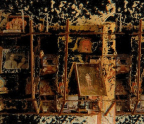Relevant Permission A Conversation between Michèle Pearson Clarke and Lou Sheppard

“When I first encountered his work, I immediately thought that we must be thinking about some of the same things,” Michèle Pearson Clarke remarked of Lou Sheppard. “And I always found it interesting that his work was rarely contextualized as addressing grief (even by him), because to me it is so viscerally present in his practice.”
Here, the two artists engage in a lively repartee about their works that sometimes, but often don’t, position grief as an immediately legible central subject—in either case, seeing grief as a kind of inextricable lens. Sheppard articulates a parallel to queerness, writing “I don’t really think of my work as ‘queer’ but I do see queerly.” They go on to discuss navigating the spectacle of queer pain, dispensing with vulnerability as a kind of “generosity,” and understanding play as a sign of maturation—the other side of exhaustively strategic attempts to represent marginalized experience according to someone else’s criteria. Clarke and Sheppard bring their own experiences, vernaculars, and motivations to muse about coaxing grief from private space, cultivating subtle, sincere, shared arenas.
Lou Sheppard: Grief feels very familiar, but also vast and amorphous, and thinking about it has made me realize that I’m not that sure what it is. In a Euro-, Ameri-, and colonio-centric world it feels like experiences of grief are tightly scripted—grief is an emotional state that follows a linear trajectory of healing, a response to loss or trauma. But in my experience, grief feels more like a presence, or like a timescale, or even a lens that I see the world from. I have felt that grief has its own temporality, its own dimensional qualities, and that you become entangled in it, or maybe it in you. What is grief
You’re reading a preview, subscribe to read more.
Start your free 30 days





